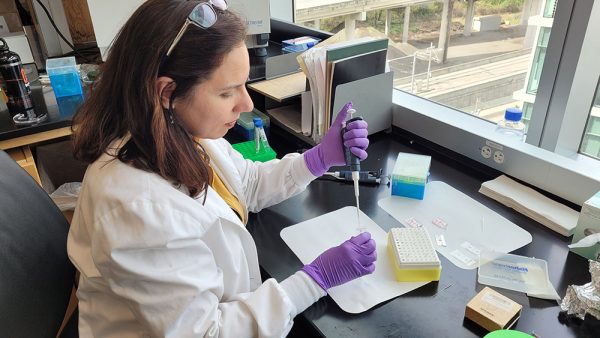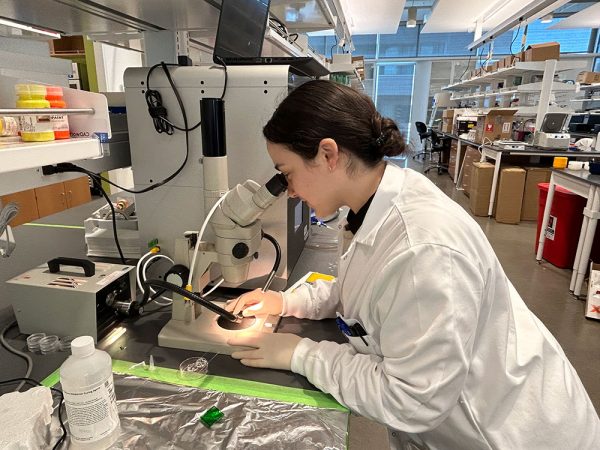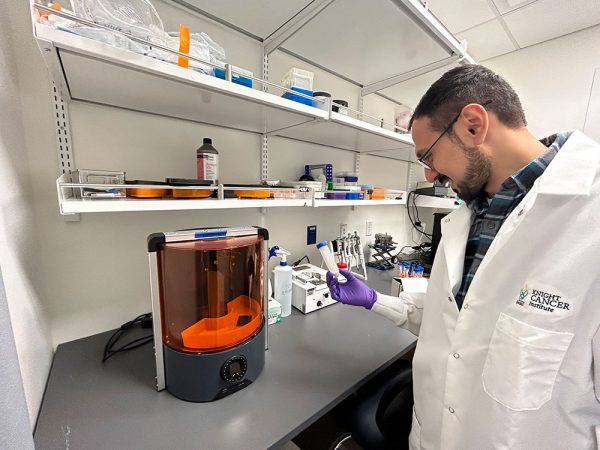From Academic Collaboration to RegendoDent, Inc.: One (Dentin) Bridge at a Time
Vital Pulp Therapy (VPT) is a true innovation in regenerative biomaterials for endodontic treatment.
 Today, the only form of regenerative endodontic therapy available is a technique called revascularization, where the patient’s own blood is used to create a clot in the dental canal with the hope that the biologic nature of the autogenous material will support pulp regeneration. This technique has not been widely adopted by endodontists, and even less so by general practitioners (GPs), because of its unpredictable clinical outcomes. Consequently, a regenerative biomaterial that could produce more predictable results would very likely be well-received by dentists and patients.
Today, the only form of regenerative endodontic therapy available is a technique called revascularization, where the patient’s own blood is used to create a clot in the dental canal with the hope that the biologic nature of the autogenous material will support pulp regeneration. This technique has not been widely adopted by endodontists, and even less so by general practitioners (GPs), because of its unpredictable clinical outcomes. Consequently, a regenerative biomaterial that could produce more predictable results would very likely be well-received by dentists and patients.
RegendoGEL, a first in class resorbable, is a regenerative hydrogel with bioactive ingredients that stimulate the tooth’s own healing process. Key benefits of RegendoGEL include that it is biocompatible, resorbable and non-inflammatory; it is able to regenerate dental pulp and dentin; and it is easily applied into the pulp chamber.
RegendoGEL will enable RegendoDent Inc. to provide a novel platform for dental, oral, and craniofacial (DOC) regenerative technologies. Currently the dental regenerative area of the DOC arena includes periodontal tissue, bone and soft tissue regeneration, but not dental pulp regeneration. Similar to dentin and enamel regeneration products, dental pulp regeneration via RegendoGEL would provide a new and exciting opportunity for anyone working to advance regeneration in DOC indications.
From the start, RegendoDent Inc. has been a stellar example of a collaborative, interdisciplinary project in the MPWRM Resource Center’s ITP program. The project began with a research collaboration between Tufts University and Oregon Health and Sciences University (OHSU), where the two Principal Investigators (PIs) combined their complementary expertise in scientific research and clinical innovation.
PI Pamela C. Yelick, PhD is a Professor in the Department of Orthodontics at Tufts University School of Dental Medicine, with adjunct appointments in the Genetics, Molecular & Cellular Biology Program, Tufts Graduate School of Biomedical Sciences, TUSM and the Department of Biomedical Engineering, Tufts School of Engineering. She is an internationally recognized leader in dental tissue engineering and craniofacial development, with over 120 peer-reviewed basic research publications, more than two dozen reviews, and over 500 abstracts since the year 2000. She has received national and international acclaim for her research on dental tissue and whole tooth tissue engineering and has participated in over 300 Invited Speaker Lectureships.
 Co-PI Luiz Bertassoni DDS, PhD is a Professor of Restorative Dentistry at OHSU, and also holds appointments at the OHSU Center for Regenerative Medicine and Department of Biomedical Engineering. Dr. Bertassoni leads a multidisciplinary research group working on various aspects of biomaterials and tissue engineering. His recent work on bioprinting vascularized tissue engineering constructs has received extensive attention in the popular media, including Fox News, The BBC, The Guardian, Fox Business, Wired.com, Tech Crunch, and others, and was selected as one of the top 100 science stories of 2014 (#64) by Discover Magazine. Dr. Bertassoni’s research includes: the use micro-scale technologies and bioprinting for tissue engineering; nanoscale structural and mechanical properties of mineralized tissues; and various aspects of the emerging field of ‘organs-on-a-chip’.
Co-PI Luiz Bertassoni DDS, PhD is a Professor of Restorative Dentistry at OHSU, and also holds appointments at the OHSU Center for Regenerative Medicine and Department of Biomedical Engineering. Dr. Bertassoni leads a multidisciplinary research group working on various aspects of biomaterials and tissue engineering. His recent work on bioprinting vascularized tissue engineering constructs has received extensive attention in the popular media, including Fox News, The BBC, The Guardian, Fox Business, Wired.com, Tech Crunch, and others, and was selected as one of the top 100 science stories of 2014 (#64) by Discover Magazine. Dr. Bertassoni’s research includes: the use micro-scale technologies and bioprinting for tissue engineering; nanoscale structural and mechanical properties of mineralized tissues; and various aspects of the emerging field of ‘organs-on-a-chip’.
Combining their research and interests in the regenerative DOC field, Yelick and Bertassoni have been able to effectively move the RegendoGEL technology through the product development pathway toward clinical acceptance and ultimately to patients who would benefit from a product for regenerative endodontic treatment.
 When accepted into the ITP program, they expanded their collaborative efforts to universities involved with the MPWRM Resource Center (RC), including the University of Michigan, University of Pittsburgh and the Wyss Institute at Harvard University. The RC was able to help the ITP team with a market assessment to clarify the indication and clinical need, and the value proposition for RegendoGEL. Clinical advisors for the RC worked with the team to assess clinical challenges and opportunities in the endodontic space. The RC also helped the team establish a commercialization plan and go to market strategies that would encourage clinical adoption of the product. Based on that commercialization plan, the new company RegendoDent Inc. was established in 2022, and a CEO was hired.
When accepted into the ITP program, they expanded their collaborative efforts to universities involved with the MPWRM Resource Center (RC), including the University of Michigan, University of Pittsburgh and the Wyss Institute at Harvard University. The RC was able to help the ITP team with a market assessment to clarify the indication and clinical need, and the value proposition for RegendoGEL. Clinical advisors for the RC worked with the team to assess clinical challenges and opportunities in the endodontic space. The RC also helped the team establish a commercialization plan and go to market strategies that would encourage clinical adoption of the product. Based on that commercialization plan, the new company RegendoDent Inc. was established in 2022, and a CEO was hired.
All of the steps being undertaken in this phase of the project would not have been supported by other forms of research funding. Our regular discussions with the Market Assessment Cores regarding adoption and pricing have been especially helpful, and have helped us shape a unique value proposition that we will test with prospective customers.
 Several ITP teams would benefit from an effective dental reimbursement strategy. RegendoDent is well positioned to achieve this through a collaboration with Delta Dental, the sole member of several non-profit dental insurance companies.
Several ITP teams would benefit from an effective dental reimbursement strategy. RegendoDent is well positioned to achieve this through a collaboration with Delta Dental, the sole member of several non-profit dental insurance companies.
The RC also helped the RegendoDent team prepare a presentation to Delta Dental that resulted in a $100,000 research grant for the RegendoGEL project. This funding suggests that RHSC supports the significant potential value RegendoGEL offers for all elements of the dental reimbursement system as a regenerative therapy to restore natural tooth structures. Patients, providers, payers, and plan purchasers should all see the benefits of a product such as RegendoGEL.
The RegendoDent team anticipates a relatively fast 510(k) regulatory strategy that will not require a human clinical trial for FDA submission. For potential strategic partners, the fact that the product will be cleared for commercialization without the time and cost of a clinical trial is a significant advantage. The RC regulatory core has been instrumental in assisting the team with the necessary documentation to implement this strategy.
With a secured commercial partner and FDA clearance, a clinical development plan will be initiated to support additional claims for the regenerative superiority of RegendoGEL over currently available products. At that point, the product will have been on the market long enough for that clinical development plan to be grounded in real world clinical needs and experiences.
An interinstitutional agreement for licensing between OHSU and Tufts has been finalized, and an option to license the technology by RegendoDent is underway. The RC Market Assessment and Commercialization Cores are working with RegendoDent to develop a market map and a target list of potential strategic partners. Through the RC industry network, RegendoDent Inc. has been able to interact with several companies and has multiple NDAs in place that will allow for exploration of commercialization partnership opportunities for RegendoGEL.
The current RegendoDent goal for FDA submission and clearance by 2025 seems very achievable and will lead to this exciting technology being available to benefit patients in the very near future.
For any questions/interests in the projects, please contact us at
translationalrc@umich.edu
